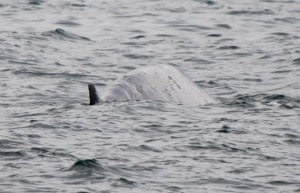This post originally appeared in The Science Times:
Marine Biology Professor in San Francisco State University, Dr. Jonathan Stern cited the uncommon fin whale with a scientific name of “Balaenoptera Physalus,” was probably a young one.
In a report published by the techienews.co.uk, Stem said the fin whales have special lingering blow that makes them unique. The spotted whale was flourished, yet a bit thin with many Pennella or Parasitic Copepods. Reports added that the spotted whale is the second biggest animal on Earth, after the blue whale. They can develop to 26 meters long, measure 70 tons and could reach 90 years of life span.

(Photo : Janine Harles / Puget Sound Express Whale Watching , Times Colonist) A juvenile fin whale is seen on Thursday, five kilometres south of Minor Island, near Whidbey Island, in Washington state.
According to the managing director of the Puget Sound Express Whale-Watching, Michael Harris, the fin whales have been seen in the territory around Puget Sound and Vancouver Island just a couple times in the previous 20 years.
Harris is hoping this is not the first time that fin whales will be seen in their area and he added that the fin whale’s appearance may be identified with the climate change.
“The unusual warm weather this summer led to an algae bloom stretching from California to British Columbia, leading to a situation where food for the whales is not plentiful. It’s possible the fin whale could be swimming further afield in search of fish,” Harris quoted at the vancouversun.com.
Fin whales were usually seen in the Salish Sea until business chasing in the most recent century killed their population.
Harris stated other whale species, for example, the humpback and the dim have turned out to be more regular on the west shore of Washington state and B.C. in late decades, Harris said. These resurgences took after single whale sightings.